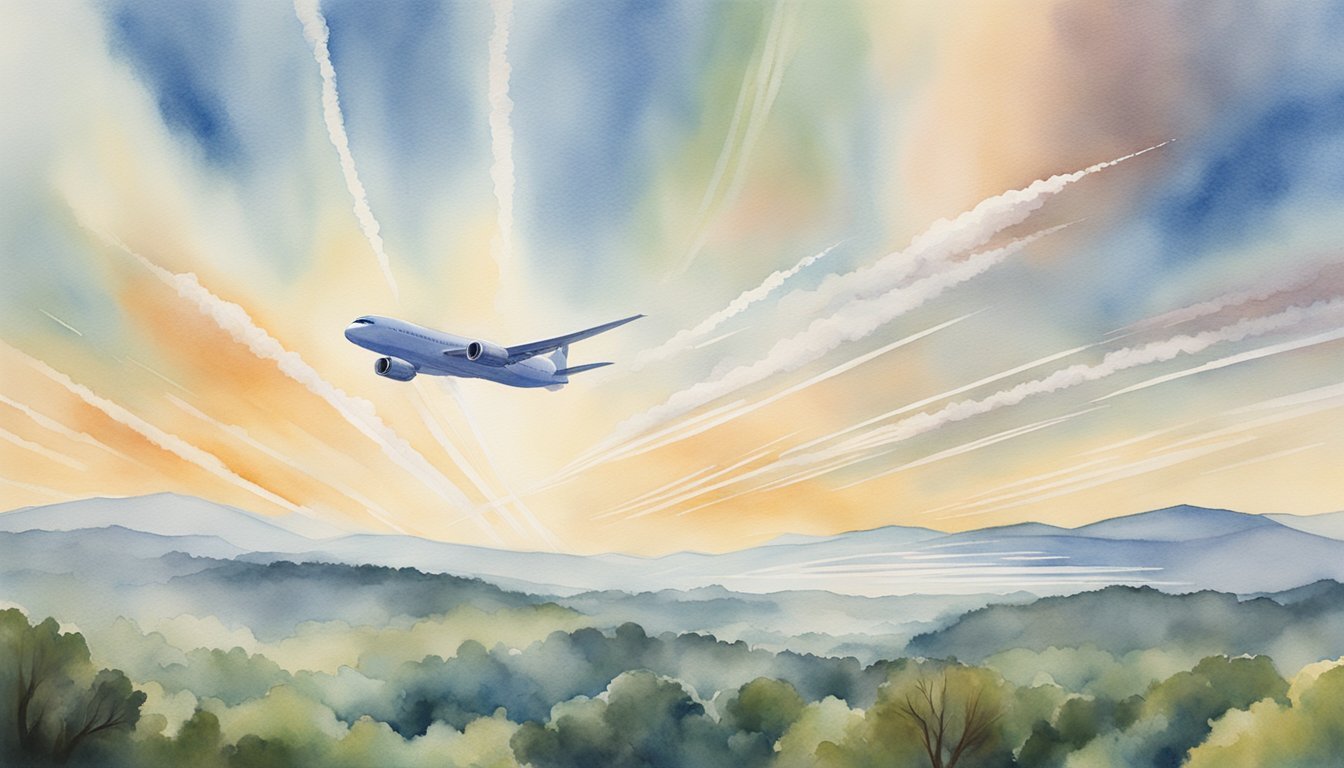Understanding Airplane Contrails

Airplane contrails are fascinating phenomena that occur when the right mix of temperature, humidity, and particles come together in the atmosphere. They’re not just a product of flight but a scientific wonder worth exploring.
Formation and Composition
Contrails, short for condensation trails, are essentially clouds formed by the water vapor that is emitted as exhaust from an aircraft engine. This water vapor quickly condenses into tiny water droplets or ice crystals when it comes in contact with the cold air at high altitudes. The required humidity for contrail formation is higher than that for typical cloud creation, which is why they may not form on every flight.
In addition to water vapor, contrails are composed of small particles from the engine exhaust, including soot and sulfur compounds, which provide a surface for the water vapor to condense onto. Understanding the properties of contrails is vital in studying their effects on the climate since they can influence the Earth’s radiation balance.
Contrails vs. Cirrus Clouds
Contrails are often mistaken for cirrus clouds, but they have distinct origins. While both are high-level clouds composed mostly of ice crystals, contrails are directly generated by aircraft. On the other hand, cirrus clouds occur naturally without human intervention. However, under the right conditions, contrails can spread and evolve into cirrus-like clouds, often referred to as “contrail cirrus,” increasing the overall cloudiness in the sky.
The impact of contrails on the environment, particularly their role in global warming, has garnered increasing interest. It’s found that in ice-supersaturated regions, contrails can persist and contribute to climate change by trapping outgoing infrared radiation.
Understanding the dynamics of aircraft wakes helps in determining how contrails spread and their subsequent transformation into larger cloud systems. Researchers use specialized campaigns, such as the CONCERT campaign, to observe the lifecycle of contrails and enlighten the curious minds about the influence of these man-made clouds on our planet’s atmosphere.
Impacts on Climate and Environment

When airplanes journey across the sky, they leave more than just a trail of white streaks; they leave a complex fingerprint on our planet’s climate and air quality.
The Warming Effect of Contrails
Contrails, short for condensation trails, are essentially clouds formed from the water vapor released by aircraft engines which quickly condenses in the cold, high altitudes. Under certain atmospheric conditions, these contrails persist and spread, evolving into contrail-induced cirrus clouds. They contribute to climate change by trapping outgoing infrared radiation, similar to the way greenhouse gases function, and thus, have a warming effect on the Earth’s surface. The link between contrails and increased radiative forcing, a key measure of the impact on climate, is a growing area of concern, considering the rising volume of global air traffic and the quest to curb temperature increase as part of global warming mitigation.
- Global warming: Contrails contribute to the Earth’s warming.
- Radiative forcing: A measure of influence that factors such as contrails have on the climate.
- Temperature: Impacted by contrails when they act as a blanket, trapping heat.
Contrails and Air Quality
Contrails are not only about global temperatures; these high-flying clouds also affect local air quality. The same soot particles that provide nuclei for water vapor to condense and form contrails can be implicated in air quality degradation. The high altitude jet emissions include not just CO2, or carbon dioxide, but other substances that have complex effects on atmospheric composition. While CO2 impacts the global environment over the long term, it’s the more immediate presence of released soot and other particulates in the air that can locally degrade air quality. The discussion actively involves the aviation industry as researchers explore the environmental cost of flight and seek more sustainable practices.
- CO2: Carbon dioxide is a long-lived greenhouse gas.
- Soot particles: Particles which can catalyze the formation of contrails and degrade air quality.
- Altitude: Higher aircraft altitudes where contrails form can influence their environmental impact.
While we often marvel at the sight of contrails painting the blue canvas above us, the importance of thoroughly understanding and addressing their environmental impact grows along with the aviation industry. Recent studies, such as those examining the potential for mitigating the climate forcing of aircraft contrails suggest that changes in technology and flight paths might offer pathways to lessen their negative effects.
Research and Mitigation Strategies

Keeping our skies more environmentally friendly, recent studies and initiatives are honing in on innovative methods to curb the climate impact of airplane contrails. From tweaking fuel compositions to smarter flight routes, here’s how science is charting a greener course through the clouds.
Advances in Fuel Technology
Researchers are actively exploring how sustainable aviation fuel (SAF) and biofuels can reduce the formation of contrails. By lowering soot emissions, these greener alternatives significantly lessen contrail formation, which NASA and others in the field deem vital for climate health. For instance, a study by the American Chemical Society underscores the potential of technology adoption to mitigate contrail-induced climate forcing.
Flight Path and Altitude Adjustments
Tweaking flight paths and cruising altitudes offers yet another avenue to contrail mitigation. The Aerospace Research Central provides insights on how modifying aircraft trajectories, particularly in the presence of specific wind conditions, can decrease persistent contrail creation. Moreover, research on how slight altitude changes can minimize contrail climate impact leads the way to practical adjustments in day-to-day flight operations.
Policy and Regulatory Considerations
All this research feeds into the essential drumbeat of policy formulation. Regulators, including entities like the Federal Aviation Administration and government bodies, are critical in implementing these strategies at scale. The Massachusetts Institute of Technology highlights operational strategies for contrail mitigation that could be adopted by regulators, harmonizing environmental goals with aviation industry operations.

